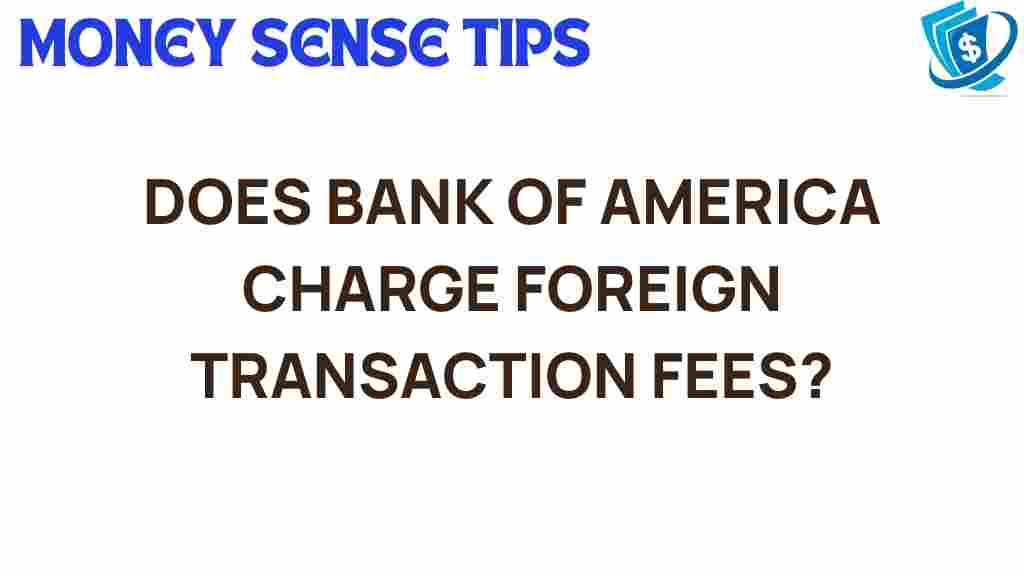Unraveling Foreign Transaction Fees: What You Need to Know About Bank of America
When planning a trip abroad, one of the key factors to consider is how to manage your finances effectively. Among the various banking fees, foreign transaction fees can significantly impact your travel expenses. If you are a Bank of America customer, understanding these fees is essential for maximizing your savings on international purchases. In this article, we will delve into what foreign transaction fees are, how they apply to Bank of America credit cards, and provide you with finance tips to minimize these costs while traveling.
Understanding Foreign Transaction Fees
Foreign transaction fees are charges that credit card companies impose on purchases made outside your home country. These fees typically range from 1% to 3% of the transaction amount and can add up quickly if you are making multiple purchases during your travels. Bank of America, like many other financial institutions, has specific policies regarding foreign transaction fees, which are important to understand before your next international trip.
How Bank of America Handles Foreign Transaction Fees
Bank of America applies foreign transaction fees to its credit cards, but the amount can vary depending on the specific card you hold. Here’s a breakdown:
- Standard Credit Cards: Most of Bank of America’s standard credit cards charge a foreign transaction fee of 3% on every international purchase.
- Premium Credit Cards: Some premium cards, like the Bank of America Premium Rewards credit card, do not charge foreign transaction fees at all.
It’s crucial to check the specific terms of your credit card agreement or contact Bank of America customer service to confirm the applicable fees for your card.
Impact on Travel Expenses
Foreign transaction fees can significantly increase your overall travel expenses. For instance, if you spend $1,000 abroad with a standard Bank of America credit card, you could incur an additional $30 in fees. Over the course of a trip, these fees can accumulate, diminishing your travel budget. Understanding how to navigate these fees can help you allocate your finances more effectively.
Finance Tips to Avoid Foreign Transaction Fees
To help you save on foreign transaction fees while using your Bank of America credit card, consider the following tips:
- Choose the Right Card: If you travel frequently, consider applying for a credit card that does not charge foreign transaction fees, such as the Bank of America Premium Rewards card.
- Use Local Currency: When making purchases abroad, opt to pay in the local currency rather than in U.S. dollars. This practice often results in lower fees.
- Plan Your Purchases: Limit international purchases to avoid racking up foreign transaction fees. Use cash for smaller transactions or local services.
- Keep an Eye on Exchange Rates: Be aware of the current exchange rates to ensure you are not overpaying. Use Bank of America’s online tools to track rates.
- Monitor Your Statements: Regularly check your credit card statements for any unexpected fees or charges related to foreign transactions.
Step-by-Step Process to Minimize Banking Fees
To make the most of your banking experience while traveling, follow these steps:
Step 1: Research Your Card
Before your trip, research the specific foreign transaction fees associated with your Bank of America credit card. Visit the Bank of America website for detailed information on each card’s terms and conditions.
Step 2: Apply for a No-Fee Card
If your current card incurs foreign transaction fees, consider applying for a card that does not charge these fees. This can save you significant money while traveling.
Step 3: Use Cash Wisely
Determine how much cash you will need during your travels and withdraw it before you leave to avoid using your credit card for every small transaction. This minimizes your exposure to fees.
Step 4: Be Aware of Dynamic Currency Conversion
When offered the choice between paying in your home currency or the local currency, always choose the local currency. This helps you avoid additional fees associated with dynamic currency conversion.
Step 5: Track Your Spending
Use mobile banking apps to monitor your transactions and manage your expenses in real-time. This helps you stay within your budget and quickly identify any unexpected fees.
Troubleshooting Foreign Transaction Fees
If you notice unexpected foreign transaction fees on your statement, here’s what you can do:
Review Your Transactions
Go through your recent transactions to identify any purchases made outside the United States. This will help you understand where the fees originated.
Contact Customer Service
Reach out to Bank of America customer service for clarification on any charges. They can provide detailed information about your transactions and the fees applied.
Dispute Charges if Necessary
If you believe a charge is incorrect, you can dispute it directly through your Bank of America account. Provide any necessary documentation to support your case.
Conclusion
Understanding foreign transaction fees is essential for anyone using a Bank of America credit card for international purchases. By knowing how these fees work, choosing the right credit card, and implementing finance tips to minimize costs, you can enhance your travel experience and reduce unnecessary banking fees.
As you prepare for your next adventure, keep these insights in mind to ensure you make the most of your finances while traveling abroad. For further information on managing your banking and travel expenses, visit Bank of America for resources and tools that can help you stay on top of your finances.
This article is in the category Services and created by MoneySenseTips Team
